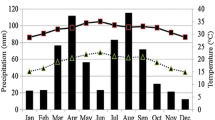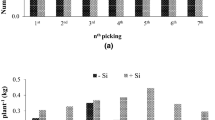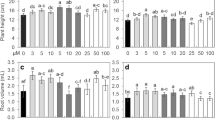Abstract
Seeking for safe and cheap alternatives to provide the nutrient requirements of crops remains the most significant alternative for obtaining healthy and economical products. Thus, the present study aimed to assess the efficiency of aqueous water hyacinth shoot extract as a source of nutrients to feed tomato plants. Therefore, the effects of three fertilization treatments (without foliar spraying, commercial synthetic solution and natural solution of water hyacinth shoot extract) on the nutritional status and biomass yield of tomato were investigated. The experiment was designed in a randomized complete block design with three replicates. At different growth stages, several macro- and micronutrients, in addition to the final yield at harvest, were estimated. The results showed that at all growth stages of tomato (vegetative, flowering, fruiting and maturity), the natural solution of water hyacinth caused the maximum increases in phosphorus, iron, zinc, manganese, and selenium. However, the differences between the natural solution of water hyacinth and synthetic solution in nitrogen and potassium at the vegetative stage, phosphorus at the flowering and the fruiting stages, and manganese and selenium at the maturity stage were not significant. The increases in fresh and dry weights and fruit yield of tomato plants owing to the natural solution of water hyacinth application were 37.5, 56.8 and 72.2%, respectively, over the control. Natural organic solution of water hyacinth application increased the net return of tomato cultivation by approximately 1.84 and 1.63 times compared with the conventional practice (control) and synthetic chemical solution, respectively. It could be concluded that exploiting the natural organic solution of water hyacinth achieves several profits in agriculture via fertilization programs by enhancing the income of tomato farmers. Accordingly, it is recommended to benefit from the wastes of water hyacinth plants that are annually removed from the Nile River and other waterways.
Zusammenfassung
Die Suche nach sicheren und kostengünstigen Alternativen zur Deckung des Nährstoffbedarfs von Pflanzen ist nach wie vor die wichtigste Alternative zur Gewinnung gesunder und wirtschaftlicher Produkte. Daher zielte die vorliegende Studie darauf ab, die Wirksamkeit von wässrigem Wasserhyazinthen-Sprossenextrakt als Nährstoffquelle für Tomatenpflanzen zu bewerten. Daher wurde die Wirkung von drei Düngebehandlungen (ohne Blattspritzung, kommerzielle synthetische Lösung und natürliche Lösung aus Wasserhyazinthen-Sprossenextrakt) auf den Nährstoffstatus und den Biomasseertrag von Tomaten untersucht. Das Experiment wurde in randomisiertem vollständigen Blockdesign mit drei Wiederholungen konzipiert. In verschiedenen Wachstumsstadien wurden verschiedene Makro- und Mikronährstoffe sowie der endgültige Ertrag bei der Ernte geschätzt. Die Ergebnisse zeigten, dass in allen Wachstumsstadien von Tomaten (Vegetations‑, Blüte‑, Frucht- und Reifestadium) die natürliche Lösung der Wasserhyazinthe die maximale Zunahme von Phosphor, Eisen, Zink, Mangan und Selen verursachte. Die Unterschiede zwischen der natürlichen Lösung der Wasserhyazinthe und der synthetischen Lösung bei Stickstoff und Kalium im vegetativen Stadium, bei Phosphor im Blüte- und Fruchtstadium sowie bei Mangan und Selen im Reifestadium waren jedoch nicht signifikant. Die Zunahme des Frischgewichts, des Trockengewichts und des Fruchtertrags der Tomatenpflanzen durch die Anwendung der natürlichen Lösung der Wasserhyazinthe betrug 37,5, 56,8 bzw. 72,2 % gegenüber der Kontrolle. Die Anwendung der natürlichen organische Lösung der Wasserhyazinthe erhöhte den Nettoertrag des Tomatenanbaus um das etwa 1,84- bzw. 1,63-Fache gegenüber der herkömmlichen Praxis (Kontrolle) bzw. der synthetischen chemischen Lösung. Daraus lässt sich schließen, dass die Nutzung der natürlichen organischen Lösung der Wasserhyazinthe in der Landwirtschaft über Düngeprogramme mehrere Gewinne erzielt, indem sie das Einkommen der Tomatenbauern steigert. Dementsprechend wird empfohlen, die Abfälle von Wasserhyazinthenpflanzen, die jährlich aus dem Nil und anderen Gewässern entfernt werden, zu nutzen.

Similar content being viewed by others
References
Abdel Shafy HI, Farid MR, Shams El-Din AM (2016) Water-hyacinth from Nile River: chemical contents, nutrient elements and heavy metals. Egypt J Chem 59:131–143. https://doi.org/10.21608/ejchem.2016.934
Abdelhamid MT, Horiuchi T, Oba S (2004) Composting of rice straw with oilseed rape cake and poultry manure and its effects on faba bean (Vicia faba L.) growth and soil properties. Bioresour Technol 93:183–189. https://doi.org/10.1016/j.biortech.2003.10.012
Al-Gasimi ASH, Yeaser AKH, Soheep MW, Bhiah KM (2018) Effect of adding different levels of fermented Nile flower plant (organic fertilizer) on some soil chemical properties, nutrients contents and wheat plant growth. Plant Arch 18:1767–1770. https://doi.org/10.13140/RG.2.2.28066.89287
Ali S, Abbas Z, Rizwan M, Zaheer IE, Yavaș I, Ünay A, Abdel-Daim MM, Bin-Jumah M, Hasanuzzaman M, Kalderis D (2020) Application of floating aquatic plants in phytoremediation of heavy metals polluted water: a review. Sustain 12:1927. https://doi.org/10.3390/su12051927
Awad HEA (2008) Ecology and adaptation of water hyacinth in the Nile delta ecosystem. M.SC. Thesis, Botany Dept Fac Sci Cairo Univ, p 116
Baral B, Vaidya GS (2011) Biological and chemical assessment of water hyacinth (Eichhornia crassipes (Mart.) solms.) of Phewa Lake, Nepal. Sci World 9:57–62. https://doi.org/10.3126/sw.v9i9.5520
Baral B, Vaidya GS, Bhattarai N (2011) Bioactivity and biochemical analysis of water hyacinth (Eichhornia crassipes). Bot Orient J Plant Sci 8:33–39. https://doi.org/10.3126/botor.v8i0.5556
Casella G (2008) Statistical design, 1st edn. Springer, Gainesville, pp 32611–38545
Chapman HD, Pratt PF (1961) Methods of analysis for soils, plants and waters. Division of Agric Sci, Berkeley Univ, Berkeley, pp 150–152
Cimmyt (1988) From agronomic data to farmer recommendation: an economic workbook DF, pp 31–33
Cottenie A, Verloo M, Kiekens L, Velgh G, Camerlynech R (1982) Chemical analysis of plants and soils. State Univ, Ghent
Dandelot S, Robles C, Pech N, Cazaubon A, Verlaque R (2008) Allelopathic potential of two invasive alien Ludwigia spp. Aqua Bot 88:311–316. https://doi.org/10.1016/j.aquabot.2007.12.004
De Ponti T, Rijk B, Van Ittersum MK (2012) The crop yield gap between organic and conventional agriculture. Agric Syst 108:1–9. https://doi.org/10.1016/j.agsy.2011.12.004
FAO (2014) Food and agricultural organization of the United Nations FAOSTAT: crop data. http://www.fao.org/faostat/en/#data/QC. Accessed 7 Jan 2016
Feng W, Xiao K, Zhou W, Zhu W, Zhou Y, Yuan Y, Xiao N, Wan X, Hua Y, Zhao J (2017) Analysis of utilization technologies for Eichhornia crassipes biomass harvested after restoration of wastewater. Bioresour Technol 223:287–295. https://doi.org/10.1016/j.biortech.2016.10.047
Haggag MW, Abou El Ella SM, Abouziena HF (2017) Phytochemical analysis, antifungal, antimicrobial activities and application of Eichhornia crassipes against some plant pathogens. Planta Daninha 35:E17159560. https://doi.org/10.1590/S0100-83582017350100026
Ilo OP, Simatele MD, Nkomo SPL, Mkhize NM, Prabhu NG (2020) The benefits of water hyacinth (Eichhornia crassipes) for Southern Africa: a Review. Sustain 12(21):9222. https://doi.org/10.3390/su12219222
Indulekha V, Thomas CG (2018) Utilization of water hyacinth as mulch in turmeric. J Trop Agric 56:27–33
Jafari N (2010) Ecological and socioeconomic utilization of water hyacinth (Eichhornia crassipes Mart Solms). J App Sci Environ Manage 14:43–49. https://doi.org/10.4314/jasem.v14i2.57834
JrJ B (2001) Laboratory guide for conducting soil test and plant analysis. CRC Press, Boca Raton London, New York Washington, D.C https://doi.org/10.1201/9781420025293
Kabata-Pendias A, Pendias H (2000) Trace elements in soils and plants, 3rd edn. CRC Press, Boca Raton https://doi.org/10.1201/9781420039900
Khan AA, Bibi H, Ali Z, Sharif M, Shah SA, Ibadullah H, Khan K, Azeem I, Ali S (2017) Effect of compost and inorganic fertilizers on yield and quality of tomato. Acad J Agric Res 5:287–293 (https://www.academiapublishing.org/journals/ajar/pdf/2017/Oct/Khan%20et%20al.pdf)
Klute A (1986) Methods of soil analysis, part I, 2nd edn. Wisconsin, Madison, USA
Kumar P, Sharma SK (2004) Integrated nutrient management for sustainable cabbage-tomato cropping sequence under mid hill conditions of Himachal Pradesh. Ind J Hortic 61:331–334
Kwabiah AB, Stoskopf NC, Palm CA, Voroney RP, Rao MR, Gacheru E (2003) Phosphorus availability and maize response to organic and inorganic fertilizer inputs in a short-term study in Western Kenya. Agric Ecosys Environ 95:49–59. https://doi.org/10.1016/S0167-8809(02)00167-6
Li F, He X, Srishti A, Song S, Tan HTW, Sweeney DJ, Ghosh S, Wang CH (2021) Water hyacinth for energy and environmental applications: a review. Bioresour Technol 327:124809. https://doi.org/10.1016/j.biortech.2021.124809
Luttikholt LWM (2007) Principles of organic agriculture as formulated by the International Federation of Organic Agriculture Movements. NJAS Wageningen J Life Sci 54:347–360. https://doi.org/10.1016/S1573-5214(07)80008-X
Mahanta K, Jha DK, Rajkhowa DJM‑K (2012) Microbial enrichment of vermicompost prepared from different plant biomasses and their effect on rice (Oryza sativa L.) growth and soil fertility. Biol Agric Hort 28:241–250. https://doi.org/10.1080/01448765.2012.738556
Mohamed MS, Rashad RT (2020) Studying some characteristics of sandy soil amended by water hyacinth, bean straw, and compost. Egypt J Soil Sci 60:53–65
Nath S, Singh K (2016) Analysis of different nutrient status of liquid biofertilizer of different combinations of buffalo dung with gram bran and water hyacinth through vermicomposting by Eisenia fetida. Environ Dev Sustain 18:645–656
Osoro N, Muoma JO, Amoding A, Mukaminega D, Muthini M, Ombori O, Maingi JM (2014) Effects of water hyacinth (Eichhornia crassipes [mart.] solms) compost on growth and yield parameters of maize (Zea mays). Br J App Sci Technol 4:617–633
Piccardi N, Manissier P (2009) Nutrition and nutritional supplementation: impact on skin health and beauty. Derm Endocrinol 1:271–274. https://doi.org/10.4161/derm.1.5.9706
Peirce CAE, McBeath TM, Priest C and McLaughlin MJ (2019) The timing of application and inclusion of a surfactant are important for absorption and translocation of foliar phosphoric acid by wheat leaves. Front Plant Sci. 10:1532. https://doi.org/10.3389/fpls.2019.01532
Poudel D, Mandal RA, Ghimire RP (2018) Effects of leaves extract of Eichhornia crassipes on seed germination and seedling growth of Pinus roxburghii and Bauhinia purpurea. J Aqua Sci Mar Biol 1:13–19
Sanchez-Moreno C, Plaza L, De Ancos B, Cano MP (2006) Nutritional characterization of commercial traditional pasteurized tomato juices: carotenoids, vitamin C and radical-scavenging capacity. Food Chem 98:749–756. https://doi.org/10.1016/j.foodchem.2005.07.015
Sharma B, Suthar S (2021) Enriched biogas and biofertilizer production from Eichhornia weed biomass in cow dung biochar-amended anaerobic digestion system. Environ Technol Innov 21:101201. https://doi.org/10.1016/j.eti.2020.101201
Sindhu R, Binod P, Pandey A, Madhavan A, Alphonsa JA, Vivek N, Gnansounou E, Castro E, Faraco V (2017) Water hyacinth a potential source for value addition: an overview. Bioresour Technol 230:152–162. https://doi.org/10.1016/j.biortech.2017.01.035
Singh JS, Pandey VC, Singh DP (2011) Efficient soil microorganisms: a new dimension for sustainable agriculture and environmental development. Agric Ecosys Environ 140:339–353. https://doi.org/10.1016/j.agee.2011.01.017
Unpaprom Y, Pimpimol T, Whangchai K, Ramaraj R (2021) Sustainability assessment of water hyacinth with swine dung for biogas production, methane enhancement, and biofertilizer. Biomass Conv Bioref 11:849–860. https://doi.org/10.1007/s13399-020-00850-7
Vallverdu-Queralt A, Jauregui O, Medina-Remon A, Lamuela-Raventos RM (2012) Evaluation of a method to characterize the phenolic profile of organic and conventional tomatoes. J Agric Food Chem 60:3373–3380. https://doi.org/10.1021/jf204702f
Wasonga CJ, Sigunga DO, Musandu AO (2008) Phosphorus requirements by maize varieties in different soil types of Western Kenya. Afr Crop Sci J 16:161–173. https://doi.org/10.4314/acsj.v16i2.54361
Watanabe FC, Olsen SR (1965) Test of an ascorbic acid method for determining phosphorus in water and NaHCO3 extracts from soils. Soil Sci Soc Am Proc 29:677–678. https://doi.org/10.2136/sssaj1965.03615995002900060025x
Woese K, Lange D, Boess C, Bogl KW (1997) A comparison of organically and conventionally grown foods-results of a review of the relevant literature. J Sci Food Agric 74:281–293. https://doi.org/10.1002/(SICI)1097-010(199707)74:3%3C281:AID-JSFA794%3E3.0.CO;2-Z
Yu F‑B, Luo X‑P, Song CF, Zhang M‑X, Shan S‑D (2010) Concentrated biogas slurry enhanced soil fertility and tomato quality. Acta Agric Scand Sect B Soil Plant Sci 60:262–268. https://doi.org/10.1080/09064710902893385
Funding
This research was technically supported by the Faculty of Agriculture, Ain Shams University, Egypt.
Author information
Authors and Affiliations
Corresponding author
Ethics declarations
Conflict of interest
A. M. Elgala, S. H. Abd-Elrahman, H. S. Saudy and M. I. Nossier declare that they have no competing interests.
Rights and permissions
About this article
Cite this article
Elgala, A.M., Abd-Elrahman, S.H., Saudy, H.S. et al. Exploiting Eichhornia crassipes Shoots Extract as a Natural Source of Nutrients for Producing Healthy Tomato Plants. Gesunde Pflanzen 74, 457–465 (2022). https://doi.org/10.1007/s10343-022-00622-5
Received:
Accepted:
Published:
Issue Date:
DOI: https://doi.org/10.1007/s10343-022-00622-5




